My Remington 700 in 7 mm Remington Magnum has always performed well.
Though I bought it in 1991, and used it hard since then, it remains my go-to rifle for nasty weather big game hunts. Here is why it works for me.
by Leon Pantenburg
Imagine we’re sitting around a campfire at a hunting camp somewhere high in the western mountains. Dinner, made in a Dutch oven over coals, is over, libations have been served and the hunting stories start.
They go something like this: Lost? Well, not really. I knew where I was, and that the Clearwater River, (in Central Idaho), was due west. All I had to do was follow my compass, walk out about two miles, hit the highway, and take a right. But I couldn’t walk west. Rather, I was walking north, then west, then north again, and then backtracking east… It was a classic case of “You can’t get there from here.” A massive timber blowdown that clogged up the mid-mountain area for a couple of miles, and there was no way to get through it.
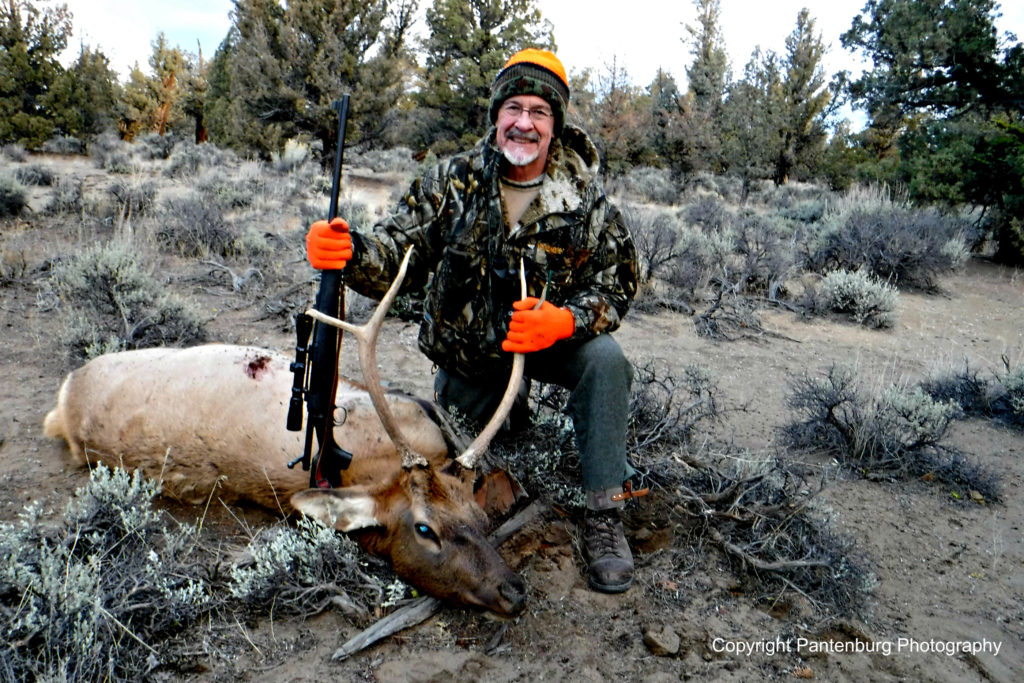
2015, Oregon: This bull elk dropped in its tracks after one shot from my 7 Mag. (My fluorescent vest was removed for the photo.)
But I followed that herd of elk for about two hours. They had walked and foraged near the top of the blowdown and finally bedded down. I snuck a little closer. Finally, about 100 yards away I got a clear shot at a five-point bull. I put the crosshairs of the scope on his chest. I knew my 7 Mag (Remington 700 in 7 millimeter Remington Magnum) could drop that bull in its tracks.
Pause. Let the anticipation mount.
I whispered “Bang” and then eased back into the timber. That bull was as good as dead, IMO, but it was too warm. Butchering the animal and getting the meat out unspoiled would have been virtually impossible. There were about two hours of daylight left, and I wasn’t sure of the best path to get back to the road. Besides, I would mark the spot on my topo map, and come back at first light with two more hunters. With luck, we’d come across the herd again.
That was just one of many backcountry big game hunting experiences where I carried a 7 Mag.
Finding that “best all-around” hunting rifle is as elusive as finding the “best overall hunting/bushcraft/survival knife.” Like any outdoors gear, you have to look at what the item will be used for, what conditions it most likely would be used under, and how much you want to spend. Being a “seasoned” hunter, I am naturally drawn to classic knives and firearms. The elk hunters I associate use a variety of calibers, including a .338 Winchester Magnum, 300 Winchester, .270 and 7 Mag. Several have reported kills with a .243 and the venerable 30.06 is the most represented caliber.
When I moved to Idaho in 1990, it was with the intention of hunting elk every year. And I did. My hunting partner, my brother Mike Pantenburg, and I did every kind of hunt, from Friday afternoons, when we’d sneak out of work early to hunt the weekend, to multi-day backpack hunts in the back country.

This Remington 700 synthetic 7 mm is my bad weather rifle and has been carried extensively elk hunting in the west since 1991.
My infatuation with the 7 Mag started early, when I started reading Warren Page’s writing in “Field and Stream” back in the 60s. Page, the magazine’s gun editor, took more than 450 heads of game with his 7mm Mashburn Super Magnum, a custom wildcat cartridge. The Mashburn was the inspiration for the 7 mm Remington Magnum. The 7 Mag went on to become the world’s most popular belted cartridge.
My first centerfire rifle was a used Winchester 670 30.06 (Old Ticklicker) that I bought in Nebraska in 1977. It killed a lot of deer for me. But I still had to have a 7 Mag. (I was single at the time and didn’t have to justify every firearms purchase to a wife.) Besides, the plan was to move out West and hunt big game, so obviously, I needed an elk rifle. I got my first 7 mag, a Remington 700 BDL, in 1986 when I lived in Washington D.C.
I sold Old Ticklicker (to my eternal regret!) to a good friend in the early 80s so I could buy a Remington BDL 700 in 7mm-08. (Ticklicker went on to slay some 40+ deer in Mississippi before it was handed down to my buddy’s son. The rifle still harvests several deer every year.) My 7mm-08 is used extensively for swamp and mountain hunting, and has never failed. (At last count, the 7mm-08 has killed 26 deer with 26 consecutive shots.) I briefly considered the 300 Winchester and the .338 for my elk rifle, but rejected them because of the extra weight and recoil.
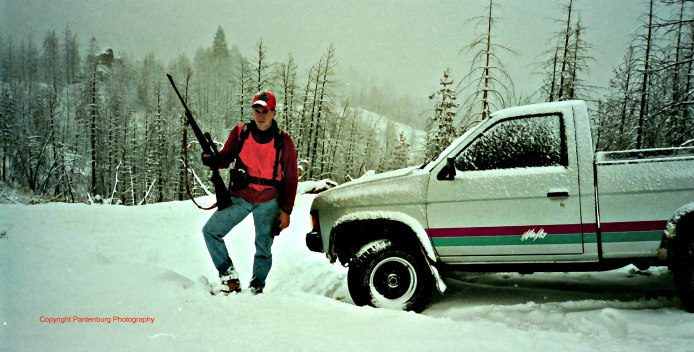
This 1996 Idaho elk hunt featured deep snow and slippery mountain roads. Mike was carrying his 7 Mag.
After my first Idaho elk hunt in 1990, I decided I needed a weatherproof rifle, so I upgraded to a Remington 700 with a composite stock, also in 7 Mag. I mounted a 2×7 power Nikon scope on it, and that became my western deer/elk rifle. That 7 Mag has been carried a couple thousand miles in the mountains, through all sorts of weather. It holds its zero with monotonous regularity. My annual fall sight-in is a ritual that is probably not necessary and it generally takes three shots.
Being an avid handloader, I immediately set out to find the ultimate elk load. After considerable reading, research and experimenting, I settled on a 160 grain Speer Grand Slam, exiting the muzzle at about 3,000 feet per second. My brother Mike moved to Idaho shortly after I did, and he also bought a Remington 700 in 7 Mag. Both rifles were very accurate with the same load. Mike has used that load on everything – deer, elk and antelope.
The Good Stuff:
Load: The 7 mm Remington Magnum offers ballistics better than the .30-06 Springfield with bullet weights of 175 grains and less, one of the more popular loads being a 160 grain spitzer loaded to 3,000 ft/s
Because the 7 Mag and 30-06 are so popular, everyone loads for them, and there’s a whopping choice of bullets. In factory ammo, the 7 Mag Magnum is somewhat more expensive, but the difference won’t break you. As far as bullets by themselves are concerned, the 7 Mag does very well. The practical range of bullet weights for the 7 Mag goes from 140 grains to 175 grains, with all sorts of stops in between. Some custom bullet makers produce 7 millimeter bullets in the 190 grain range.
Accuracy: There is a reason many competitive long range shooters use the 7 mag – the accuracy is legendary. Every year before hunting season, Mike and I had a contest. The best three-shot group off sandbags on the bench, using the hunting load, won a beer and bragging rights until the next year. I was doing my annual sight in at Black’s Creek Gun range in Boise, and the range officer was next to me, watching me shoot through a spotting scope. Off the bench, the rifle shot a witnessed 3/8-inch, three-shot group with 162 grain Grand Slams.
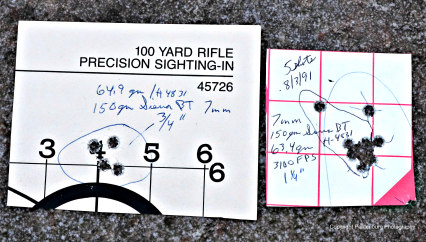
My 7 Mag is very accurate. This is excellent accuracy for an off-the-shelf rifle that has not been accurized.
High Ballistic Coefficient: Basically, this is a measure of how streamlined a bullet is. In ballistics, the ballistic coefficient (BC) of a bullet is a measure of its ability to overcome air resistance in flight. A high BC means the object will slow down less, meaning it will have a flatter trajectory over long ranges. The 7 Mag’s BC, depending on the bullet and velocity is exemplary.
Flat shooting: I sight in all my centerfire rifles to group three inches high at 100 yards. This puts the rifle dead on at 25 yards. This sight-in has worked for me for decades in the Idaho back country, Oregon high desert and Mississippi swamps.
With that zero I can aim at center mass at any distance from the muzzle out to 300+ yards. I don’t shoot further than that. I prefer to hunt, and that means stalking closer to the animal.
Manageable recoil: A hard-kicking rifle may quickly teach you how to flinch and jerk the trigger. The 30.06, the gold standard for hunting rifles IMO, and the 7 Mag both recoil over 20 foot pounds of recoil energy. (Check out this comparison story) Generally speaking, a 7 Mag will back up about three pounds more than a 30.06. In short, recoil in manageable for most people.
Availability: Finding ammunition is always a consideration, as in the case of your baggage getting separated from your rifle case. At one backwoods store in Idaho, I checked for ammunition. There was plenty of 30.06, .270 and 7 Mag. No other calibers were available.
It is also easy to find the rifle you want in 7 Mag. They are much more common than many other, more exotic calibers.
You might want to consider this:
Too much gun? Personally, I think the 7 Mag with a factory load is too powerful for whitetail deer in much of the United States. I shot an Idaho mule deer at 192 paces a few years back. The 160-grain Speer Spitzer, screaming out of the muzzle at almost 3,100 FPS, ruined most of the meat in the front half of the animal and totally destroyed the offside shoulder. The bullet was the wrong choice for that application. (I grabbed the wrong box of cartridges out of the truck, and had meant to use a 160 grain Speer Grand Slam!) But if you are hunting mainly in the west, where long shots are the rule, rather than the exception, a 7 Mag with the right bullet is a good choice.
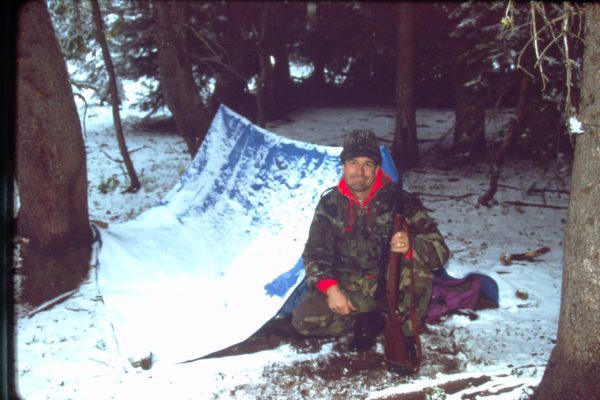
Opening day 1990, somewhere in the Idaho backcountry. After this hunt, I decided I needed an all-weather rifle.
If I were going to hunt whitetails with a 7 mag in the southeastern swamps, where a long shot would be 100 yards, I’d reduce the velocity to about 2,500-2,700 feet per second and use a 150 grain bullet. I’ve had excellent results with the 150 grain Sierra Game King.
A 7 mag wouldn’t be my first choice for a hog gun. In the southern swamps I hunt, shots at hogs may be close and in heavy brush. Experienced hog hunters I know prefer the 45-70, in a fast handling lever gun. At the other extreme, though, are long shots over a field. In those cases where long range knockdown power is needed, a 7 Mag with a heavy bullet is an excellent choice.
So do you need a 7 Mag?
That’s your choice. I know many experienced hunters who can argue persuasively for their pet caliber, and who can back it up with years of experience and field use. And my favorite rifle might be one you abhor.
If shopping for firearms and trying out new calibers is not for you, just buy a good bolt action 30.06 with a good four power scope and let it go with that. That rifle will do everything you need it to.
But that’s no fun. For hardcore hunters, the preparation can provide as much enjoyment as the actual hunt. Find a caliber, rifle design and hunting cartridge you like and go with it. That will be the best combination for you, and it will probably become your pet hunting rifle.
Please click here to check out and subscribe to the SurvivalCommonSense.com YouTube channel – thanks!


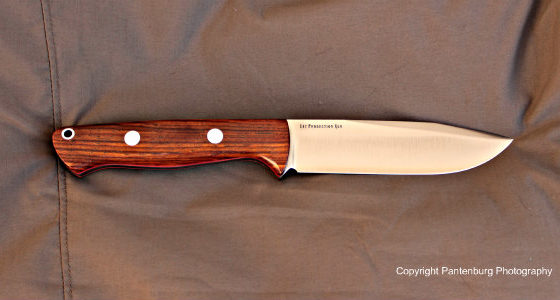

Leave a Reply